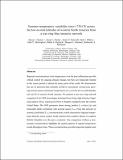Files in this item
Summer temperature variability since 1730 CE across the low-to-mid latitudes of western North America from a tree ring blue intensity network
Item metadata
| dc.contributor.author | Heeter, Karen J. | |
| dc.contributor.author | Harley, Grant L. | |
| dc.contributor.author | Maxwell, Justin T. | |
| dc.contributor.author | Wilson, Rob J. | |
| dc.contributor.author | Abatzoglou, John T. | |
| dc.contributor.author | Rayback, Shelly A. | |
| dc.contributor.author | Rochner, Maegen L. | |
| dc.contributor.author | Kitchens, Katherine A. | |
| dc.date.accessioned | 2022-07-28T23:47:17Z | |
| dc.date.available | 2022-07-28T23:47:17Z | |
| dc.date.issued | 2021-09-01 | |
| dc.identifier | 275306883 | |
| dc.identifier | 611f4a75-1592-4e9d-afcb-50773dbde931 | |
| dc.identifier | 85111337494 | |
| dc.identifier | 000689254600002 | |
| dc.identifier.citation | Heeter , K J , Harley , G L , Maxwell , J T , Wilson , R J , Abatzoglou , J T , Rayback , S A , Rochner , M L & Kitchens , K A 2021 , ' Summer temperature variability since 1730 CE across the low-to-mid latitudes of western North America from a tree ring blue intensity network ' , Quaternary Science Reviews , vol. 267 , 107064 . https://doi.org/10.1016/j.quascirev.2021.107064 | en |
| dc.identifier.issn | 0277-3791 | |
| dc.identifier.other | RIS: urn:7A8CF8A78E3018A497EF27213EBD2724 | |
| dc.identifier.other | ORCID: /0000-0003-4486-8904/work/98196429 | |
| dc.identifier.uri | https://hdl.handle.net/10023/25750 | |
| dc.description | This project was supported by the National Science Foundation under BCS- 2012482, BCS-1759694, and AGS-2002524, the United States Forest Service, the University of Idaho, and Indiana University Institute for Advanced Studies. | en |
| dc.description.abstract | Regional reconstructions of air temperature over the past millennium provide critical context for ongoing climate change, but they are temporally limited in the recent period or absent for many parts of the world. We demonstrate the use of latewood blue intensity (LWB) to reconstruct current-year growing (warm) season maximum temperatures (Tmax) in the low-to-mid latitudes (30°-50°N) of western North America. We present a new tree ring network comprised of 26 LWB chronologies developed from living, high-elevation Engelmann spruce (Picea engelmannii Parry ex Engelm.) sampled across the western United States. The LWB parameter shows strong, positive (r = 0.65–0.73), and temporally-stable correlations with growing season Tmax. From this network we present 4 regional Tmax reconstructions, which characterize regional temperature histories across western North America from northern Mexico to southern British Columbia over the past 4 centuries. Our comparison of these 4 temperature reconstructions highlights the spatial patterns of regional temperature trends throughout time. These reconstructions provide important updates and increased data point density to the tree ring temperature proxy network of the Northern Hemisphere. We highlight the use of blue intensity methods at both low- and mid-latitude upper tree line locations to increase the presence of strongly temperature-sensitive records at increasingly lower latitudes of the Northern Hemisphere. | |
| dc.format.extent | 2664305 | |
| dc.language.iso | eng | |
| dc.relation.ispartof | Quaternary Science Reviews | en |
| dc.subject | Dendrochronology | en |
| dc.subject | Climate change | en |
| dc.subject | Latewood blue intensity | en |
| dc.subject | Temperature reconstruction | en |
| dc.subject | GE Environmental Sciences | en |
| dc.subject | 3rd-DAS | en |
| dc.subject | SDG 13 - Climate Action | en |
| dc.subject | AC | en |
| dc.subject.lcc | GE | en |
| dc.title | Summer temperature variability since 1730 CE across the low-to-mid latitudes of western North America from a tree ring blue intensity network | en |
| dc.type | Journal article | en |
| dc.contributor.institution | University of St Andrews. School of Earth & Environmental Sciences | en |
| dc.contributor.institution | University of St Andrews. Scottish Oceans Institute | en |
| dc.identifier.doi | 10.1016/j.quascirev.2021.107064 | |
| dc.description.status | Peer reviewed | en |
| dc.date.embargoedUntil | 2022-07-29 | |
| dc.identifier.url | https://www.sciencedirect.com/science/article/pii/S0277379121002717?via%3Dihub#appsec1 | en |
This item appears in the following Collection(s)
Items in the St Andrews Research Repository are protected by copyright, with all rights reserved, unless otherwise indicated.

